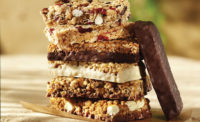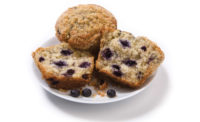An ever-changing library of ingredients is helping bakers and snack producers create the next generation of products that deliver on health, taste and labeling claims. And inclusions, fillings and toppings are just some of the vehicles they’re using to add nutritional ingredients to bars, breads, cake and more.
“Probably the most-persuasive trend influencing the food and beverage industries is clean- and clear-labeling,” says Jeannie Swedberg, director of business development, Tree Top Inc., Selah, WA. “Not only do consumers want recognizable ingredients in the products they buy, they want a short ingredient list. This goes to the desire for purity and authenticity. While this trend may have started with millennials, it’s now a trend spanning the entire consumer spectrum.”
Dave Caucutt, vice president, sales and technical service, Lawrence Foods, Elk Grove Village, IL, says: “Our customers are looking for products that add flavor and texture without adding unnecessary ingredients to the declaration. The ultimate goal is to create products that consumers crave, and texture plays a key role in product differentiation.”
Changing government regulations also prompting bakers and snack producers to update their ingredients and formulations. Last July, FDA proposed including a percent daily value for “added sugars” on the Nutrition Facts panel. FDA’s Dietary Guideline Advisory Committee recommends that Americans limit their daily added sugars intake to less than 10 percent of total calories.
Fruit for thought
Incorporating fruit into fillings, inclusions and toppings helps bakers and snack producers address changing consumer desires and dietary guidelines. Fruit can add fiber, functional benefits and sweetness to baked goods and snacks. In addition, fruit has a health halo.
“Any snack can be exonerated via blueberries,” says Tom Payne, industry specialist, U.S. Highbush Blueberry Council, Folsom, CA. “The presence of blueberries adds tremendous appeal. Thanks to all the good news about antioxidants and health benefits, blueberries have almost become synonymous with good health.”
Blueberries’ sweetness works well with the more “spicy, savory and assertive flavors,” says Payne. They also enhance and balance multidimensional flavors that combine citrus and herbaceous notes with spice, he notes. In addition, blueberry concentrate adds sweetness and color.
Bakers and snack producers should also consider dried plums. “The trend to deliver more flavor with better and fewer ingredients, a clean label and lower added sugar has inspired companies to innovate and be open-minded about trying new ideas and look at ingredients in new ways,” says Kate Leahy, culinary spokesperson, Sunsweet Ingredients, Yuba City, CA. “For instance, some of our customers have found they can lower sugar and increase fiber by using Sunsweet dried plums in protein bars. Because dried plums have sorbitol, they carry sweetness without impacting the glycemic load of a product. Dried plums can also enhance browning and take the place of artificial color.”
Leahy notes that as an inclusion, Sunsweet’s Plum Amazins hold their shape, add subtle sweetness and boost the fiber content of cookies and breakfast breads. “They can also lower the overall glycemic index in trail mixes, bars or cookies,” she explains. “Whole-wheat flatbreads get the benefit of added moisture when the purée is added to dough, and dried plums add a natural, whole-wheat appearance to gluten-free breads to help them achieve a better browning texture in place of milk powder or other browning agents that are also allergens.”
Consumers are also more appreciative of specific fruit varieties and their local ties. Jeff Manning, chief marketing officer, Cherry Marketing Institute, Dewitt, MI, points to a Mintel report that indicates consumers care more about brand stories, including ingredient sourcing (“North America16: Consumer Trends 2016,” Mintel, October 2015). As an example of a good backstory, Manning cites Montmorency cherries. “Montmorency tart cherries are a North American-grown superfruit sourced from small family orchards,” he explains. “Choosing Montmorency cherries can shape a brand story about supporting local agriculture and preserving generations-old family farms.”
Nuts for nuts
Nuts also remain popular with consumers, who are discovering their many health benefits, and with bakers and snack manufacturers, who are using them in fillings and as inclusions and toppings.
According to Molly Spence, director of North America, Almond Board of California, Modesto, almonds are full of “power-packed protein and fiber. Ounce for ounce, almonds are the tree nut highest in protein, fiber, vitamin E, calcium and niacin.” She adds that almonds’ many forms make them a desirable choice for a wide range of inclusion applications, including new variations of granola mixes and snack bars. They also add texture to snack and bakery products.
On behalf of the Turkish Hazelnut Promotion Group, Jennifer Leggett, account executive, MSLGroup, Seattle, says: “Protein alternatives are on the rise, and as consumers turn away from traditional protein sources, they are looking for more plant-based proteins, such as nuts. Hazelnuts contain 4.2 grams of protein and 2.7 grams of fiber, offering satiety and nutrient density. With the popularity of chocolate hazelnut spread, consumers are showing a passion for that flavor profile in energy bars and snacks.”
Due to allergies, not all consumers can eat nuts, though. Inclusion Technologies, Atchison, KS, offers bakers and snack producers a 100 percent nut-free allergen solution. “Nadanut offers the look, taste and, most importantly, crunch of a nut, but it’s based on wheat germ,” says Dennis Reid, vice president of sales and marketing. “Nadanut delivers the eating quality of a nut.”
Reid says the company sees “nut-free” as the next big “free-from” wave. “This is an even larger audience than gluten-free, because while gluten-free is an individual issue, nut-free is a community issue,” he explains.
Clean chocolate
According to Seema Kedia, marketing manager, food manufacturers, Barry Callebaut USA, Chicago, sustainability is tied into the clean-label trend. “We see many consumers moving from chocolates that use vanillin as an ingredient to ones that use natural vanilla, and we’ve seen a substantial increase in demand for our organic chocolate and cocoa products,” she says. Barry Callebaut offers a full range of sustainable chocolate, compound and cocoa products to meet this demand.
Bill Vlach, food technologist, Cargill Cocoa & Chocolate North America, Milwaukee, notes that the company is seeing increased customer interest in natural flavors, as well as in natural, nonsynthetic colors. “As interest in natural products has grown, we’ve developed flavor and nonsynthetic color options that align with today’s consumer demands.” he says.
Innovative options
Bakers and snack manufacturers can also add nutritional benefits, flavor, mouthfeel and visual appeal to products via customized inclusions. QualiTech Inc., Chaska, MN, recently launched Pell-ettes Plus, a line of inclusions designed to provide high-sheen visual appeal and a chewy texture to products, says Denise Radke, marketing manager. “Pell-ettes can include fruit content and deliver consistent piece identity of fruit bits.”
Qualitech can formulate inclusions to add fiber, protein or fruit content, or to enable claims. “We can also design nutrient content equal to real superfruits or deliver desired nutrients in a more-concentrated form than the whole fruit counterparts,” Radke adds.
Another way for bakers and snack producers to add nutrition to products is via pulses. Jennifer Tesch, chief marketing officer, Healthy Food Ingredients LLC, Fargo, ND, parent company of SK Food International, says all the good health benefits of pulses are prompting customers to ask how they can incorporate pulses into their products.
SK Food International offers pulses in many forms, including flakes, flour grits and raw, pre-cooked and pre-gelatinized options. Adding pre-gelantinized black bean grit to a tortilla, for example, provides color variation and texture. “In the pre-gelantized form, all starches are fully cooked, which allows appropriate binding when incorporating with masa flour,” Tesch explains.
Other up-and-coming ingredients on the market include cricket powder, which Leahy concedes is a “fringe player, but it’s definitely stirring up new conversations,” and sprouted grains.
Jenny Marino, co-owner, Angelic Bakehouse, Cudahy, WI, points out that use of sprouted grains is expected to grow eight-fold by 2018.
All of this work on building better nutritional inclusions leads to more buzz—and interest. “Millennials are looking for ‘Instagram-able’ and social media-worthy experiences,” says Kedia. “This requires brands to look at ways they can provide constant newness.”








